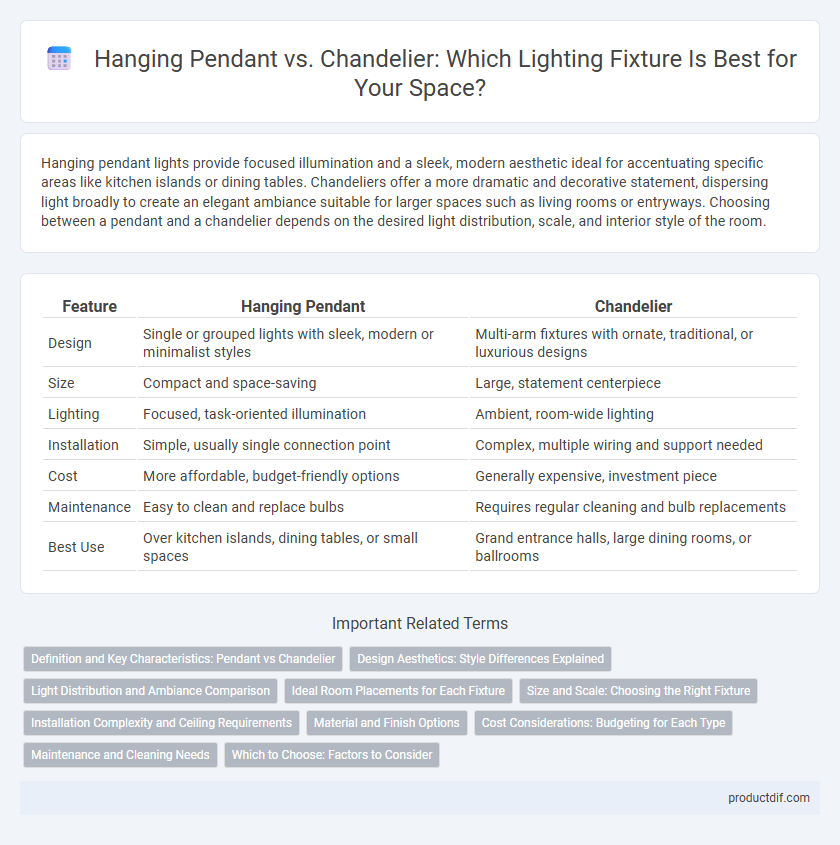Hanging pendant lights provide focused illumination and a sleek, modern aesthetic ideal for accentuating specific areas like kitchen islands or dining tables. Chandeliers offer a more dramatic and decorative statement, dispersing light broadly to create an elegant ambiance suitable for larger spaces such as living rooms or entryways. Choosing between a pendant and a chandelier depends on the desired light distribution, scale, and interior style of the room.
Table of Comparison
| Feature | Hanging Pendant | Chandelier |
|---|---|---|
| Design | Single or grouped lights with sleek, modern or minimalist styles | Multi-arm fixtures with ornate, traditional, or luxurious designs |
| Size | Compact and space-saving | Large, statement centerpiece |
| Lighting | Focused, task-oriented illumination | Ambient, room-wide lighting |
| Installation | Simple, usually single connection point | Complex, multiple wiring and support needed |
| Cost | More affordable, budget-friendly options | Generally expensive, investment piece |
| Maintenance | Easy to clean and replace bulbs | Requires regular cleaning and bulb replacements |
| Best Use | Over kitchen islands, dining tables, or small spaces | Grand entrance halls, large dining rooms, or ballrooms |
Definition and Key Characteristics: Pendant vs Chandelier
Hanging pendants are single light fixtures suspended from the ceiling, characterized by their minimalist design and focused illumination, often used in kitchens or dining areas. Chandeliers consist of multiple arms or branches holding several light bulbs, creating an ornate and larger fixture that provides ambient lighting and serves as a centerpiece in living rooms or entryways. Pendants offer versatility and targeted light, while chandeliers emphasize elegance and widespread illumination.
Design Aesthetics: Style Differences Explained
Hanging pendants feature minimalist designs with sleek lines and limited embellishments, ideal for modern and contemporary interiors. Chandeliers boast intricate craftsmanship and multiple arms or tiers, often adorned with crystals or ornate details, making them a focal point in traditional or luxurious spaces. The choice between a hanging pendant and a chandelier significantly influences the room's ambiance, balancing simplicity with opulence based on design aesthetics.
Light Distribution and Ambiance Comparison
Hanging pendants typically provide focused, directional light ideal for task or accent lighting, creating an intimate ambiance in specific areas such as dining tables or kitchen islands. Chandeliers offer broader light distribution with multiple bulbs and arms, casting a warm, ambient glow that fills larger rooms and enhances elegance. The choice between the two depends on the desired light coverage and atmosphere: pendants emphasize targeted illumination, while chandeliers deliver expansive, decorative lighting.
Ideal Room Placements for Each Fixture
Hanging pendants are ideal for focused lighting over kitchen islands, dining tables, or entryways, providing targeted illumination and enhancing specific areas. Chandeliers work best in larger spaces such as living rooms, foyers, or formal dining rooms, offering ambient light and serving as a decorative centerpiece. The choice depends on room size and lighting needs, with pendants enhancing task lighting and chandeliers creating a grand ambiance.
Size and Scale: Choosing the Right Fixture
Hanging pendants typically feature a smaller, more streamlined design ideal for focused lighting and intimate spaces, while chandeliers offer a grander scale with multiple arms, creating dramatic focal points in larger rooms. Selecting the appropriate fixture depends on ceiling height, room size, and desired visual impact to ensure balance between illumination and spatial harmony. Proper scale enhances room aesthetics, preventing an overpowering centerpiece or an underwhelming fixture that fails to provide adequate light coverage.
Installation Complexity and Ceiling Requirements
Hanging pendants typically require less installation complexity and can be mounted on standard ceilings with a single electrical junction box, making them suitable for various ceiling heights and structures. Chandeliers demand more intricate installation processes due to their weight and size, often necessitating reinforced ceiling supports and specialized wiring to ensure safety and stability. The ceiling's load-bearing capacity and height must be carefully assessed before installing chandeliers to avoid structural damage and ensure proper suspension.
Material and Finish Options
Hanging pendants often feature materials like metal, glass, and fabric shades, offering versatile finishes such as matte black, brushed brass, and polished chrome that suit modern and industrial styles. Chandeliers typically use crystal, wrought iron, or brass, with finishes including antique gold, bronze, and clear crystal accents to enhance traditional and luxurious aesthetics. Both lighting fixtures provide diverse material and finish choices, enabling customization to fit various interior design themes.
Cost Considerations: Budgeting for Each Type
Hanging pendants typically cost between $50 and $500, making them a budget-friendly option for various room sizes and styles. Chandeliers often range from $200 to over $5,000, reflecting their intricate designs and larger scale, which can significantly impact overall renovation costs. Factoring installation expenses, chandeliers usually require more complex wiring and support, increasing total budget considerations compared to simpler pendant fixtures.
Maintenance and Cleaning Needs
Hanging pendants typically have simpler designs, making maintenance and cleaning straightforward with minimal effort required to wipe down a single light source. Chandeliers often feature intricate details and multiple arms or crystals, necessitating frequent dusting and careful cleaning to preserve their elegance and sparkle. Selecting a lighting fixture should consider the time and skill needed to maintain its appearance effectively.
Which to Choose: Factors to Consider
When choosing between a hanging pendant and a chandelier, consider the room size, ceiling height, and desired ambiance; pendant lights are ideal for focused task lighting and smaller spaces, while chandeliers offer a grander aesthetic suitable for larger rooms. Evaluate energy efficiency, bulb type, and maintenance requirements to ensure functionality aligns with design preferences. Material finishes like brass, chrome, or glass impact durability and style, influencing the final decision for optimal lighting fixture selection.
Hanging pendant vs Chandelier Infographic

 productdif.com
productdif.com